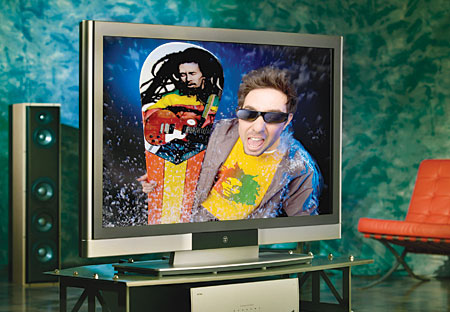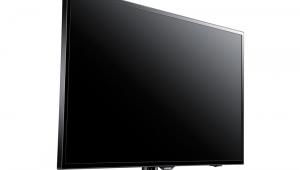Westinghouse LVM-42w2 LCD HD Monitor
Some of you may think that I call the LVM-42w2 a "true HD monitor" because I've finally acquiesced to the HDTV conspiracy theorists who insist that only 1,920-by-1,080 displays like this one should be labeled HDTVs. Don't worry—I plan to support 1080i and 720p a bit longer.

No, I've used the description "true HD monitor" for two reasons. For one, the LVM-42w2 is indeed a monitor, not a television. This LCD has neither an ATSC nor an NTSC tuner, so don't bother looking for an RF connection or onscreen program guide. They are of no use here. It also lacks a CableCARD slot or any bonus connections, such as a card reader or USB port. At least the monitor has built-in speakers and a subwoofer, discreetly hidden within the small frame, and they're capable of surprisingly robust audio.
Secondly, this monitor isn't meant to ease you into the HDTV era the way some TVs do. It was built for HDTV, and its input panel reflects that. The LVM-42w2 has a mere two entry-level video inputs (one composite, one S-video), but it's loaded with HD-capable inputs: one HDMI, two DVI, two component video, and one VGA.
The remote control has pseudo-dedicated buttons for the various inputs. By that, I mean it has dedicated buttons for VGA, S-video, and composite, plus one to toggle through HDMI and DVI and another to toggle through component video. It also has up/down buttons to scroll through the sources and an input button to move through them sequentially. I'd say that pretty much covers the input-selection process. There are only two screen sizes (standard and fill) to choose from and no automatic aspect-ratio detection.
Where It Counts
Obviously, Westinghouse chose to make the above sacrifices in order to offer this 42-inch 1080p LCD for the low price of $2,799. Just be glad they chose to sacrifice peripheral features and not the necessary staples to produce a higher-quality image, like an adjustable backlight and 3:2-pulldown detection. Although the display's internal processor didn't pick up the 3:2 film sequence on Video Essentials, it did pick it up on the Silicon Optix HQV Benchmark test disc and did an excellent job with my demo scenes from Gladiator and The Bourne Identity. Likewise, it did a poor job with video-based signals on the test discs but looked more than respectable with real-world video-based signals.
One feature that's surprisingly absent from the first crop of 1080p displays is the ability to actually accept a 1080p source. Many can only accept 1080i and 720p and then upconvert them to 1080p. That's not the case with the LVM-42w2, which can supposedly accept 1080p through all of its HD-capable inputs. To test this, I fed a 1080p signal from the NeuNeo HVD2085 DVD player to the monitor's component, DVI, and HDMI inputs. The picture looked great with DVI and component; however, with HDMI, I saw noticeable picture errors (blue, Matrix-like lines) in dark colors. We also tested the monitor's digital inputs with our reference HTPC. Again, the DVI signal looked great, but we did not get an image through HDMI. Westinghouse says that the HDMI input accepts 1080p, but we were unable to verify this with our equipment.
I also tested whether or not this monitor passes the complete 1080i interlaced signal or cheats by only passing 540 lines and then upconverting them. (See Gary Merson's article in the March 2006 issue for more information.) Happily, the LVM-42w2 passes the full signal; combine this with its excellent detail, and you'll be able to enjoy all of the information in the HDTV signal.
I should note that the monitor's HDMI and DVI inputs didn't work well with my Motorola HD cable box, which has a DVI output. I got no picture through DVI, and the HDMI input consistently lost the picture when I first powered up the monitor or changed channels. I tried multiple cable types and lengths with the same result. I had no such problems with any of the DVD players I used, so it may just be an issue with my cable box.
It Performs Well, to Boot
The LVM-42w2 looked quite good right out of the box. It offers three picture modes, vaguely labeled Color 1, Color 2, and Color 3. The default Color 1 setting is also the most accurate. Within this mode, I only had to make minor adjustments to the contrast, brightness, color (called saturation), and tint (called hue) using Video Essentials' test patterns to render a pleasing, natural image. When we measured the monitor in our lab, the results confirmed that the color temperature tracks close to 7,000 Kelvin across the board, with excellent red and blue color points. The green color point is more greenish-blue, but it's not oversaturated, so it doesn't throw the overall color balance off in a noticeable way. Calibration isn't a necessity; however, should you choose to have it done, we were able to calibrate the LVM-42w2 to track right at 6,500 K throughout much of the range.
 You can adjust the LCD's backlight in increments from 0 to 100. We measured the monitor's black level and light output at the 0, 50, and 100 backlight settings; much to our surprise, the contrast ratio was excellent in all three (894:1, 824:1, and 879:1, respectively). This gives the LVM-42w2 some valuable flexibility in terms of suitable viewing environments. If black level is your primary concern, this display bests many of the LCDs we've reviewed, producing 0.064 foot-lamberts at the 0 backlight setting. If you want a bright monitor for a bright room, it puts out a ridiculous 158.3 ft-L at the 100 setting. If you're looking for a monitor to take with you to the park on a sunny afternoon, this is the one.
You can adjust the LCD's backlight in increments from 0 to 100. We measured the monitor's black level and light output at the 0, 50, and 100 backlight settings; much to our surprise, the contrast ratio was excellent in all three (894:1, 824:1, and 879:1, respectively). This gives the LVM-42w2 some valuable flexibility in terms of suitable viewing environments. If black level is your primary concern, this display bests many of the LCDs we've reviewed, producing 0.064 foot-lamberts at the 0 backlight setting. If you want a bright monitor for a bright room, it puts out a ridiculous 158.3 ft-L at the 100 setting. If you're looking for a monitor to take with you to the park on a sunny afternoon, this is the one.
Like most LCDs, viewing angle is an issue, as the black level rises when you move even 45 degrees off-axis. The picture is still watchable but loses depth and color saturation. This is especially true when you view it from below, so you don't want to mount this LCD too high on the wall. On a positive note, the screen does not suffer from light- or color-uniformity issues.
As for my favorite test, Video Essentials' quantization test pattern, the light-to-dark ramp was one of the smoothest I've seen in an LCD flat panel, be it through the component, HDMI, or DVI input. I did see some slight banding, but there were no large jumps in the grays, which means that the LVM-42w2 is capable of producing most of the needed steps between white and black to render a clean, noise-free image.
All of these positive performance characteristics combine to create excellent TV and DVD images. Maybe a third reason to call this a true HD monitor is that HDTV in particular looks so good on the LVM-42w2. Yes, that 1080p resolution has something to do with it, bringing out every bit of detail in the picture; but let's not forget about good color balance, excellent depth, and the nondigital nature of the image. They all work together to produce a beautiful picture.
Its screen size puts the monitor in an interesting market position; 42 inches is usually a plasma screen size, while LCDs reside at either 40 or 45 inches. This monitor is certainly less expensive than any 40- or 45-inch LCD on the market, most of which are still 720p, but it's also comparably priced with many 42-inch plasmas, again at 720p. That'll certainly make the plasma-versus-LCD battle more interesting.
Regardless of where your loyalties lie, it's difficult not to be impressed by the LVM-42w2's performance. Just make sure you're ready now to enjoy all of the benefits of high definition. Get yourself an HD cable or satellite package, an upconverting DVD player, and an Xbox 360. Then your only concern will be what to do with all those extra HD inputs.
Highlights
• A noise-free, highly detailed 1080p image
• A ton of HD inputs




























































